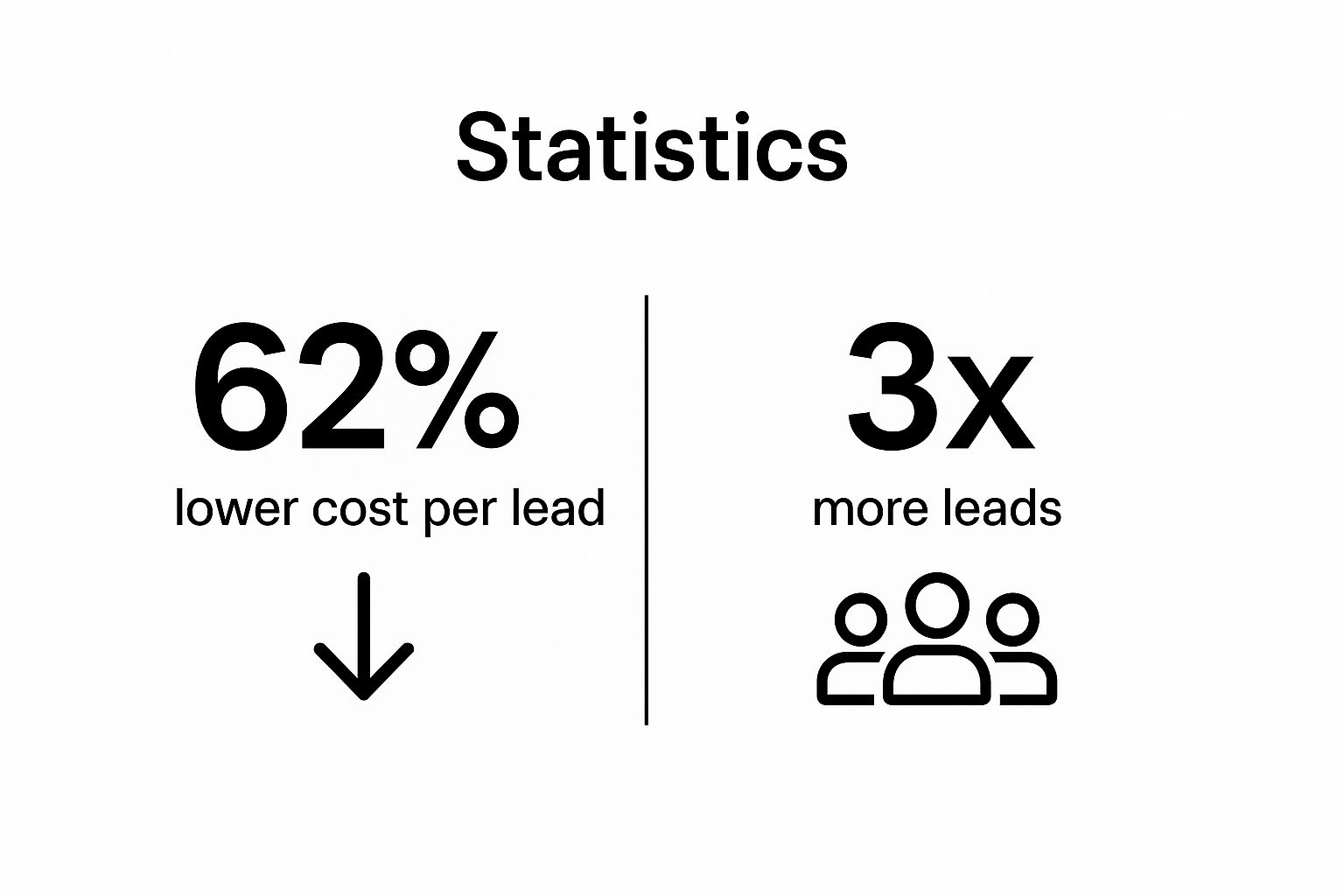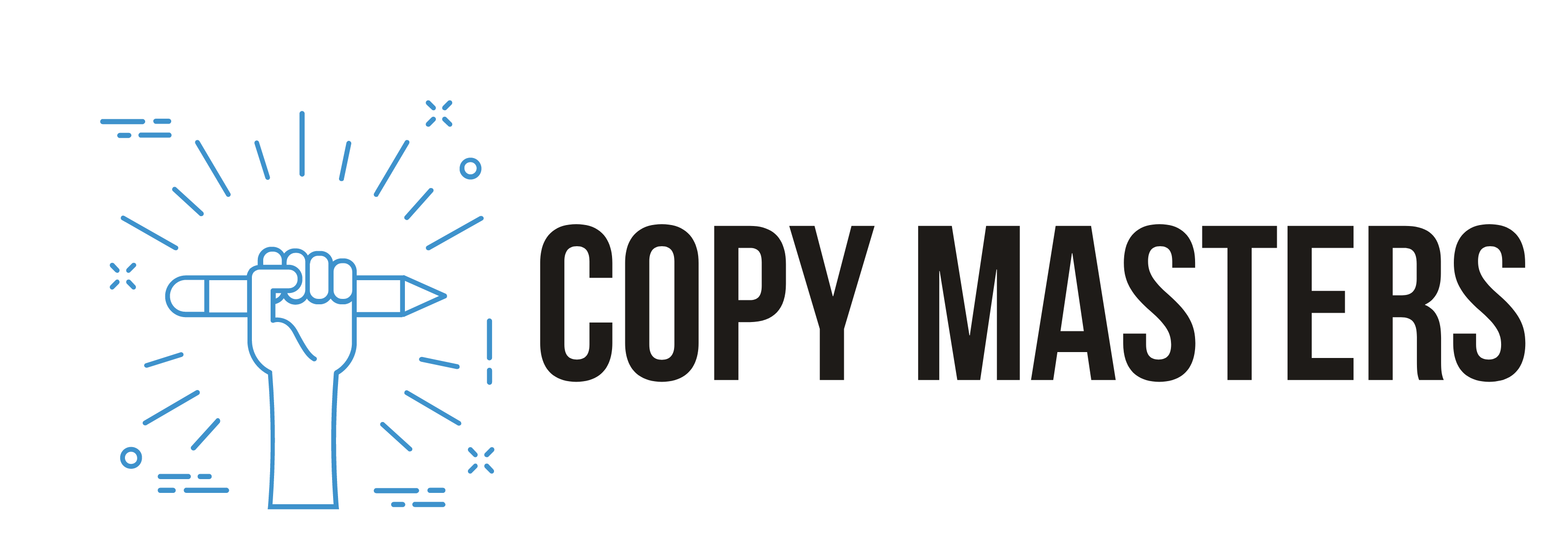In a crowded market where traditional advertising struggles to cut through the noise, sustainable growth is no longer about who shouts the loudest. Instead, it's about who builds the most trust, provides the most value, and establishes the clearest authority. This is the core function of content marketing: a strategic approach that shifts the focus from selling to helping, transforming your brand from an interruption into a trusted resource. It's a powerful system designed to attract ideal customers, engage them with valuable information, and guide them toward a solution, all while building a lasting connection.
The practical content marketing advantages extend far beyond simple brand awareness. They create a flywheel effect that strengthens nearly every aspect of your business, from lead generation to customer retention. This is not just about writing blog posts; it's about creating a strategic asset that delivers compounding returns over time.
In this comprehensive guide, we will break down the eight most impactful benefits of a well-executed content strategy. You won't find generic advice here. Instead, you'll get actionable insights, practical implementation steps, and real-world examples to help you leverage each advantage for measurable results. We will explore how to turn words into a reliable engine for long-term, profitable growth.
1. Cost-Effective Marketing with High ROI
One of the most compelling content marketing advantages is its remarkable cost-efficiency and high return on investment (ROI). Unlike paid advertising, which demands a constant budget to maintain visibility, content marketing is an asset-building activity. A single piece of high-quality, evergreen content can generate traffic, leads, and sales for years after its initial publication, creating a powerful compounding effect.
This sustainable model is particularly beneficial for businesses that need to make every marketing dollar count. It shifts the focus from "renting" audience attention through ads to "owning" it through valuable, helpful content that builds a direct relationship with potential customers.
The following infographic highlights just how impactful this approach can be compared to traditional methods.

These figures demonstrate that content marketing not only reduces lead generation costs significantly but also increases the volume of leads you can attract.
How to Maximize Your ROI
Achieving this level of efficiency requires a strategic approach. Buffer, for example, grew from zero to 100,000 users in just nine months by consistently publishing insightful blog posts. River Pools and Spas transformed their business by answering common customer questions in-depth, becoming the most visited pool website globally and massively increasing sales leads.
To replicate this success, consider these actionable steps:
- Focus on Evergreen Topics: Create content around core problems, questions, and interests in your industry that will remain relevant for years. This ensures a long-term return on your initial investment.
- Prioritize SEO: Optimize every piece of content for relevant keywords. Strong organic search rankings are the engine of sustainable, low-cost traffic and lead generation.
- Repurpose Strategically: Turn a successful blog post into an infographic, a video, a podcast episode, or a series of social media updates. This extends the reach and value of your best-performing assets without starting from scratch.
- Track Performance: To understand your true return, it's essential to track key metrics. You can learn more about how to measure content marketing ROI and connect your efforts directly to business goals.
2. Builds Trust and Establishes Authority
Another of the most significant content marketing advantages is its ability to build deep-seated trust and establish your brand as an industry authority. By consistently creating and sharing valuable, non-promotional content that solves problems and answers questions, you shift the consumer perception of your business from a seller to a trusted resource. This educational approach fosters credibility long before a purchase is ever considered.
When you freely share expertise, you demonstrate a commitment to your audience's success, which is the foundation of a strong, loyal relationship. This trust becomes a powerful competitive differentiator, as modern consumers increasingly seek out brands they believe in and can rely on for honest guidance.

This principle is at the heart of Marcus Sheridan's "They Ask, You Answer" methodology, which transformed his pool company by simply answering customer questions honestly on his blog. Similarly, Moz became the go-to authority in the SEO space through its comprehensive guides and popular Whiteboard Friday video series, which educated an entire generation of marketers.
How to Build Your Authority
To effectively build trust and establish authority, businesses should consider exploring resources on developing a robust thought leadership strategy. This involves more than just creating content; it requires a commitment to becoming the most helpful teacher in your niche.
Follow these actionable steps to build your brand's credibility:
- Answer Customer Questions Honestly: Address every question your customers have, even the difficult ones about cost, competitors, or potential problems. Transparency builds immense trust.
- Share Original Research and Data: Conduct your own studies, surveys, or experiments and publish the findings. This positions you as a primary source of information and an industry leader. For a deeper dive, you can learn more about how to write a white paper to present your research professionally.
- Be Transparent and Authentic: Openly discuss your processes, values, and even your challenges. Patagonia has built a fiercely loyal following by being transparent about its supply chain and environmental impact.
- Showcase Social Proof: Feature real customer stories, in-depth case studies, and testimonials. This provides third-party validation of your expertise and the value you provide.
3. Improves SEO and Organic Search Visibility
Another of the most significant content marketing advantages is its direct and powerful impact on search engine optimization (SEO) and organic visibility. Content is the fuel for any successful SEO strategy, as search engines like Google prioritize websites that consistently publish high-quality, relevant, and helpful information. Each optimized blog post, guide, or case study creates a new opportunity to rank for valuable keywords, attract authoritative backlinks, and strengthen your website's overall domain authority.
This process creates a flywheel effect for your business. More high-quality content leads to more indexed pages and more opportunities to earn links, which in turn leads to higher search rankings and a steady stream of organic traffic that compounds over time. Research consistently shows that websites with active blogs have drastically more indexed pages and inbound links than those without, creating a sustainable channel for customer acquisition.

This data underscores the direct correlation between consistent content creation and the core signals that search engines use to rank websites.
How to Maximize Your SEO
Achieving top search rankings requires a strategic and methodical approach to content. Brian Dean of Backlinko mastered this by creating comprehensive, data-driven guides that dominate highly competitive SEO-related keywords, attracting millions of visitors. Similarly, NerdWallet became a financial powerhouse by publishing detailed, unbiased comparison articles that answer user questions better than anyone else, securing top rankings for high-value financial terms.
To replicate this success and boost your organic visibility, focus on these steps:
- Target Search Intent: Go beyond just keywords and understand the underlying goal of the user. Are they looking to learn, compare, or buy? Structure your content to directly address that specific intent.
- Create Comprehensive Content: Develop in-depth "pillar pages" or guides that cover a topic more thoroughly than any competitor. This establishes your site as an authority and attracts more backlinks.
- Optimize On-Page Elements: Ensure every piece of content has an optimized meta title, a compelling meta description, and a clear hierarchy of headers (H1, H2, H3) that include target keywords.
- Build an Internal Linking Structure: Strategically link from new articles to your important existing pages. This helps distribute page authority throughout your site and keeps users engaged longer.
4. Generates Qualified Leads and Nurtures Prospects
One of the most powerful content marketing advantages is its ability to attract and convert high-quality leads. Unlike interruptive advertising that pushes messages on a broad audience, content marketing pulls in prospects who are actively seeking solutions to their problems. This self-selection process means the leads generated are often more engaged, educated, and ready to move forward.
By creating valuable resources tailored to each stage of the buyer's journey, from awareness to decision, businesses can systematically guide potential customers. This nurturing process builds trust and positions your brand as the go-to expert, so when the time comes to buy, you are the obvious choice. This approach leads to conversion rates up to six times higher than other methods because prospects arrive pre-qualified.
How to Maximize Your Lead Generation
Effectively turning content consumers into qualified leads requires a deliberate strategy. HubSpot excels at this by offering free tools like their Website Grader, which captures thousands of marketing-qualified leads monthly. Similarly, Salesforce uses in-depth research reports and whitepapers to attract and capture contact information from key B2B decision-makers.
To replicate this success and turn your content into a lead-generation machine, consider these actionable steps:
- Create Gated Content: Offer high-value assets like ebooks, templates, webinars, or research reports in exchange for contact information. This is a classic and effective lead capture method.
- Map Content to the Buyer's Journey: Develop specific content for awareness (blog posts, infographics), consideration (case studies, webinars), and decision stages (free trials, demos) to guide prospects seamlessly.
- Implement Lead Scoring: Assign points to leads based on their engagement with your content (e.g., downloaded an ebook, visited the pricing page). This helps your sales team prioritize the most sales-ready prospects.
- Use Clear Calls-to-Action (CTAs): Ensure every piece of content has a relevant, compelling CTA that guides the user to the next logical step, whether it's downloading a guide or requesting a consultation. For more insights, you can learn how SEO lead generation combines search visibility with effective conversion tactics.
5. Enhances Customer Engagement and Loyalty
Beyond attracting new leads, a key content marketing advantage is its power to foster deep, lasting relationships with your existing customers. Content marketing creates ongoing touchpoints that keep your brand top-of-mind and build a connection that transcends the initial transaction. By consistently providing value, you transform customers into a loyal community.
This approach shifts the customer relationship from purely transactional to deeply relational. Instead of only communicating during a sale, you become a trusted resource, an entertainer, or a source of inspiration. Engaged customers are more likely to buy again, spend more, and become vocal brand advocates, significantly increasing their lifetime value.
How to Foster Engagement and Loyalty
Building a loyal community requires more than just selling products; it requires creating a shared experience. At its heart, content marketing thrives on compelling storytelling in marketing to truly engage audiences and drive this connection. Red Bull, for instance, built an empire not by advertising energy drinks but by creating a high-octane media house around extreme sports, aligning their brand with a lifestyle their audience loves. Similarly, Glossier built its brand by prioritizing user-generated content and creating a powerful community dialogue.
To replicate this success and build a loyal following, consider these actionable steps:
- Create Exclusive Content: Offer valuable content like tutorials, behind-the-scenes looks, or early access previews exclusively for your existing customers or newsletter subscribers to make them feel valued.
- Feature User-Generated Content (UGC): Encourage customers to share their experiences with your product or service. Highlighting their stories, photos, or reviews on your platforms validates their loyalty and provides social proof.
- Build a Community Space: Establish a dedicated forum, a private social media group, or an online community where customers can connect with each other and your brand, fostering a sense of belonging.
- Deliver Personalized Value: Use email newsletters to segment your audience and deliver content tailored to their specific interests, past purchases, or engagement history.
6. Supports Multi-Channel Distribution and Amplification
A key advantage of content marketing is its inherent versatility. High-quality content isn’t a one-and-done asset; it's a foundational resource that can be repurposed, adapted, and distributed across numerous channels. This multi-channel approach allows you to maximize the value of your initial creation effort, reaching different audience segments on the platforms they prefer.
This strategy ensures your message is reinforced consistently, whether someone finds you through a blog post, a social media clip, or a podcast episode. Instead of creating entirely new content for each platform, you "atomize" a core piece, extending its reach and impact exponentially. This amplifies your message and significantly boosts the ROI of your content creation.
The concept of content atomization is powerfully explained in the video below, highlighting how to get more mileage from every piece you create.
This video shows that one great idea can fuel an entire week's worth of multi-platform content, saving time while expanding reach.
How to Maximize Multi-Channel Distribution
Effectively amplifying your content requires a systematic process. Gary Vaynerchuk’s content team famously turns a single keynote speech into over 30 individual pieces of content, including video clips, quote graphics, articles, and audiograms. Similarly, The New York Times often repurposes a major investigative article into a podcast episode for "The Daily" and a full-length documentary.
To implement this powerful strategy, follow these steps:
- Start with Pillar Content: Create a substantial, in-depth piece like a comprehensive guide, a webinar, or a research report. This "pillar" will serve as the source material for smaller "micro-content."
- Adapt Content to Platform Strengths: Don't just copy and paste. Turn key data points into an infographic for Pinterest, a detailed text post for LinkedIn, short video clips for TikTok, and engaging questions for Twitter.
- Create a Distribution Matrix: For each piece of pillar content, map out which channels you will use, what format the content will take, and when it will be published. This ensures a coordinated and strategic rollout.
- Build a Repurposable Asset Library: Organize your core content, graphics, video clips, and key quotes in an accessible library. This makes it easy for your team to quickly adapt and deploy content across channels.
7. Educates Market and Reduces Sales Friction
One of the most powerful content marketing advantages is its ability to educate your audience, which significantly reduces friction in the sales process. By creating content that preemptively answers questions, addresses common objections, and clarifies complex topics, you empower prospects to self-educate. This educational approach builds trust and positions your brand as a helpful authority long before a sales conversation ever takes place.
This strategy transforms the sales dynamic. Instead of sales teams spending time on basic education, they engage with well-informed prospects who already understand their problem and see your solution as a viable option. Companies that excel at buyer education generate 50% more sales-ready leads at a 33% lower cost because educated buyers are more confident, require less convincing, and move through the sales cycle faster.
How to Reduce Sales Friction
The core principle, popularized by Marcus Sheridan’s They Ask, You Answer methodology, is to obsessively focus on your buyers' questions and concerns. River Pools (Sheridan's company) did this by openly addressing taboo topics like pricing and potential problems, which built immense trust and drove massive sales growth. Similarly, Gong.io creates content that educates sales leaders on revenue intelligence, creating a clear demand for its product by first teaching the methodology.
To apply this educational approach, consider these actionable steps:
- Answer the "Big 5" Questions: Create dedicated content addressing pricing, problems, comparisons, "best of" lists, and reviews related to your industry. These are the topics buyers research most.
- Create Comparison Content: Develop honest, detailed comparisons between your solution and alternatives or competitors. This builds credibility and helps buyers make informed decisions.
- Document and Address Objections: Work with your sales team to list every common objection they hear. Create content, such as articles or videos, that tackles each one head-on.
- Leverage Sales Enablement: Equip your sales team with a library of educational content they can share with prospects at different stages of the buying journey to reinforce key concepts and build confidence.
8. Provides Long-Term Competitive Advantage
Another of the most powerful content marketing advantages is its ability to build a compounding competitive moat that is incredibly difficult for others to replicate. Unlike paid ad campaigns that vanish the moment you stop paying, content marketing creates a library of assets. Each article, video, and guide builds upon the last, accumulating search authority and audience trust over time.
This strategic accumulation of value establishes market dominance and captures mindshare. A business with a mature, comprehensive content library creates a significant barrier to entry. A competitor would need years and substantial investment to create an equivalent collection of resources and earn the same level of authority, giving you a sustainable, long-term edge.
How to Build Your Competitive Moat
Creating this advantage requires a long-term vision, not just tactical campaigns. For instance, Wirecutter built an unassailable advantage through thousands of exhaustive product reviews, leading to its acquisition by The New York Times. Similarly, Investopedia now dominates financial education with a content library built over decades.
To replicate this success, focus on these actionable steps:
- Cover Topics Comprehensively: Instead of writing isolated posts, aim to become the definitive resource for your core topics. Build topic clusters that cover every angle of a subject, leaving no room for competitors.
- Develop Unique Intellectual Property: Create proprietary data, original research, or unique frameworks that others cannot easily replicate. This forces competitors to cite you as the source, further strengthening your authority.
- Build Content Systems: Establish robust processes for content creation, optimization, and promotion. Consistent quality and output at scale are key differentiators that are difficult for less organized competitors to match.
- Continuously Update and Improve: Treat your content as a living library. Regularly refresh and enhance your most important articles to maintain their relevance and ranking, ensuring your advantage doesn't fade over time.
Content Marketing Advantages Comparison
| Aspect | Cost-Effective Marketing with High ROI | Builds Trust and Establishes Authority | Improves SEO and Organic Search Visibility | Generates Qualified Leads and Nurtures Prospects | Enhances Customer Engagement and Loyalty | Supports Multi-Channel Distribution and Amplification | Educates Market and Reduces Sales Friction | Provides Long-Term Competitive Advantage |
|---|---|---|---|---|---|---|---|---|
| 🔄 Implementation Complexity | Moderate – requires strategic planning & consistent content | Moderate – needs genuine expertise & authenticity | High – requires SEO know-how & ongoing optimization | High – needs content mapping & CRM integration | Moderate – requires ongoing content production | High – complex management & platform-specific adaptation | Moderate – demands honest, transparent, updated communication | High – needs years of consistent investment & innovation |
| ⚡ Resource Requirements | Low to moderate – scalable based on size, tool costs upfront | Moderate – expert content creators and quality control | High – SEO tools, technical skills, frequent updates | High – marketing automation, content, CRM integration | Moderate – content creation & community management | High – tools for scheduling, adaptation, and distribution | Moderate – content creation, training, honest communication | High – sustained content creation and system/process building |
| 📊 Expected Outcomes | ⭐⭐⭐⭐ Lower cost per lead, compounding returns | ⭐⭐⭐⭐ Increased brand credibility & trust | ⭐⭐⭐⭐ Higher rankings & organic traffic | ⭐⭐⭐⭐ Higher conversion rates, qualified leads | ⭐⭐⭐⭐ Increased customer lifetime value & loyalty | ⭐⭐⭐⭐ Maximized reach & consistent messaging | ⭐⭐⭐⭐ Shortened sales cycle & educated buyers | ⭐⭐⭐⭐⭐ Sustainable competitive moat, brand authority |
| 💡 Ideal Use Cases | Budget-conscious businesses seeking sustainable growth | Brands aiming to become thought leaders & industry authorities | Businesses focused on organic search & long-term traffic growth | Companies targeting lead generation & lead nurturing | Businesses seeking deeper customer relationships | Brands wanting to amplify content reach across multiple channels | Sales-driven companies wanting to reduce friction & objections | Companies pursuing dominant market position & defensible moat |
| ⭐ Key Advantages | Lower ongoing costs, compounding ROI, scalable investment | Builds trust, loyalty, and reputation | Sustainable SEO traffic, domain authority, keyword ranking | High-quality leads, better conversion, buyer self-education | Stronger engagement, retention, advocacy | Content repurposing, wider audience reach, brand consistency | Educated buyers, faster sales, reduced acquisition costs | Difficult to replicate, value grows over time, brand equity |
Putting These Advantages into Action
We've explored eight powerful content marketing advantages, moving far beyond simple buzzwords to reveal a strategic framework for sustainable business growth. From the undeniable ROI of an asset that appreciates over time to the deep-seated trust it builds with your audience, content marketing is less of a marketing tactic and more of a core business philosophy. It's the engine that powers SEO, nurtures leads, and creates a loyal community around your brand.
The journey through these benefits reveals a clear narrative: success in the modern digital landscape is not about the loudest message, but the most valuable one. When you prioritize educating your market, you inherently reduce sales friction. When you consistently show up with answers and solutions, you build an unshakeable authority that competitors, with their short-term ad campaigns, simply cannot replicate.
From Insight to Implementation: Your Next Steps
Understanding these advantages is the first step; the next is turning that knowledge into a tangible strategy. The most common pitfall is attempting to do everything at once. Instead, choose a single, high-impact advantage to focus on initially and build momentum.
Here’s a simple, actionable path forward:
- Identify Your Starting Point: Which advantage resonates most with your current business goals? If immediate lead generation is critical, focus on creating bottom-of-funnel content that addresses specific pain points and buying questions. If brand awareness is the priority, start by building foundational, top-of-funnel educational content to improve your SEO visibility.
- Commit to Consistency: The compounding returns we’ve discussed only materialize through consistent effort. Whether you can publish one high-quality article per month or one per week, create a realistic schedule and stick to it. Consistency signals reliability to both search engines and your human audience.
- Measure What Matters: Connect your content efforts to tangible business outcomes. Track key metrics like organic traffic growth, keyword rankings for target terms, lead conversion rates from blog posts, and customer engagement. This data will prove the ROI and guide your future content decisions.
Ultimately, the true power of content marketing is its ability to create a lasting competitive moat. Each article, guide, and video you produce is a digital asset that works for you 24/7, attracting, engaging, and converting your ideal customers. It's an investment in your brand's future, solidifying your position as a trusted leader in your industry. The path to market leadership is paved with valuable content, and the time to start building is now.
Are you ready to harness all of these content marketing advantages without the operational strain? Copy Masters specializes in creating high-quality, SEO-optimized content that builds authority and drives results, allowing you to focus on your core business. Visit Copy Masters to see how our expert writers can build your content engine for you.
- SaaS SEO Consulting for Predictable Growth - October 20, 2025
- What Is SEO Management Your Guide to Real Results - October 19, 2025
- A Guide to Quality Content for SEO That Ranks - October 18, 2025
